Having powered the data revolution, photonic integrated circuits are bringing compact, power-efficient solutions to new markets, including health care, agriculture, and automotive.
CAROL DE VRIES, PHOTONDELTA
Due to the strong association that photonic integrated circuits (PICs) have with the data and telecom markets, it is easy to overlook their potential in other verticals — such as health care, agriculture and food production, and automotive applications — where integrated photonics offers the promise for compact, energy-efficient, and innovative solutions. So what challenges are these industries facing? How is integrated photonics helping to solve these challenges? And what might the future hold?
Health care
A combination of factors is adversely affecting the provision of timely and affordable health care around the world. With an aging population, staffing shortages, and an uneven distribution of resources, health care systems are under ever-increasing pressure to do more with less. Over the next decade, rising health care costs in developed countries and access to health care in developing ones will become two of the most pressing challenges, according to the World Health Organization1.
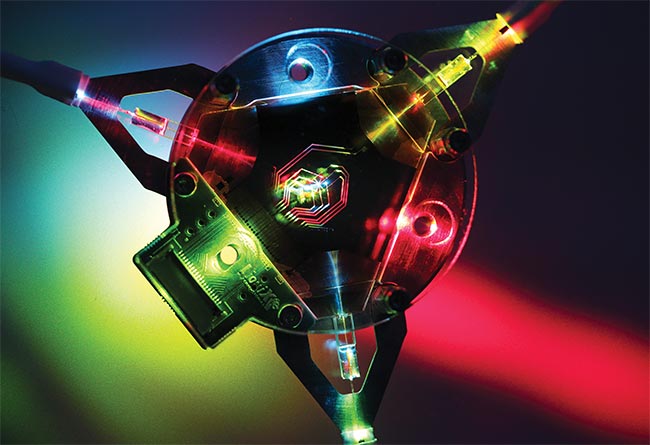
An integrated photonic module for light alignment and wavelength selection in a microscope application. The module uses three different laser inputs and combines and distributes them on chip following the user’s selection. The light is then optimized to interact with a free-space optics system. Courtesy of Carl Zeiss.
One solution to this challenge is to combine earlier and more effective diagnosis of afflictions with preventative measures designed to alleviate health problems before they arise, which provides a powerful strategy for improving health care. Before this improvement can happen, practitioners need to embrace innovative and disruptive technologies.
The beauty of integrated photonics is that it can be used to provide compact, lightweight, low-powered solutions. In a health care setting, integrated photonics can improve diagnostic support by bringing sensing, imaging, and testing to front-line health care workers and their patients. In short, integrated photonics has the potential to take medical testing out of the laboratory and into the field.
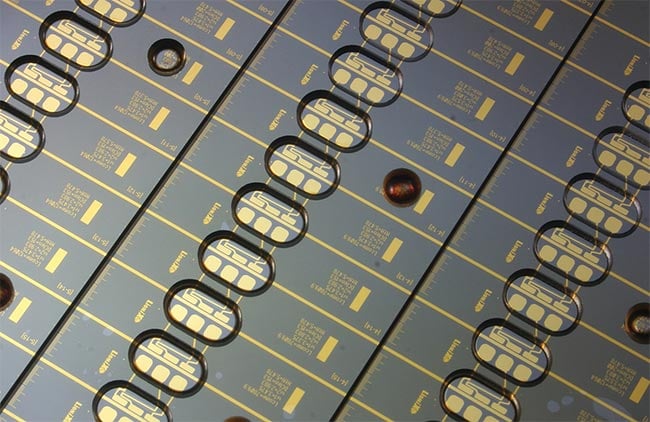
On-chip OCT has been achieved using common path interferometers and cascaded arrayed waveguide gratings on TriPleX photonic integrated circuits (PICs). CCDs are also integrated to allow immediate spectral analysis of the detected light. Courtesy of LioniX International.
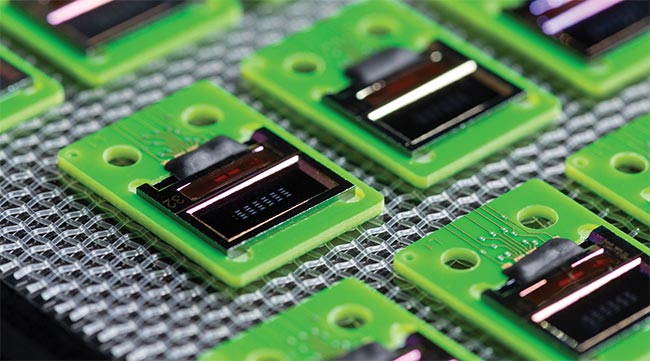
Photonic biosensors packaged by PHIX Photonics Assembly. Courtesy of Gijs van Ouwerkerk.
By bringing reliable and accurate
diagnostic devices to the front lines, health care providers save time and money while improving patient outcomes. For medical device companies, PIC-
enabled solutions unlock new and growing market opportunities. Meanwhile, patients experience speedier testing and results, and therefore gain access to the right treatment more quickly.
Applications for integrated photonics in health care range from low-cost testing and patient monitoring to point-of-care diagnostics. Interestingly, the same technology has also found applications in agriculture and food processing. By way of illustration, six examples of PIC platforms follow, along with their applications in point-of-care testing.
PIC platforms
Visible and near-infrared spectroscopy. Used in smartwatches, visible and near-infrared spectroscopy can measure vital signs such as heart rate, as well as biochemical markers for hydration and proteins. When extended to multispectral
infrared spectroscopy, PICs enable wearables to monitor an even wider range of biological information — including the level of glucose, alcohol, and protein — in a medical context.

Integrated photonics has brought laboratory analysis to the field in agri-food applications. MantiSpectra’s compact NIR sensor can yield a wealth of information about the chemical composition of produce in seconds and provide insights into optimizing growth conditions, choosing the best time to harvest, and
improving quality control in the distribution chain. Courtesy of MantiSpectra.
Raman spectroscopy. Raman spectroscopy is currently an expensive and complicated tool for measuring biochemical markers. It is probably the most challenging to integrate into a PIC. However, in terms of detection, it is the most accurate solution, and it offers a variety of applications, ranging from breath analysis to bacteria typing.
Biochips. Covering a range of test functions, from cancer cells and proteins to pollutants and contaminants, photonic biosensors provide effective rapid results. They can also diagnose noncommunicable diseases. The sensors are disposable biochip devices based on a Mach-Zehnder interferometer or ring resonator that is sensitized by a specific bioactive layer on the top.
Optical coherence tomography (OCT). Currently used across a range of medical fields — including ophthalmology, oncology, and cardiology — PIC-based OCT has the potential to improve early detection, particularly in hard-to-diagnose illnesses such as bladder cancer.
Optoacoustic, photoacoustic, and fully optical ultrasound. Already used in several medical applications, these imaging platforms direct a laser beam through soft tissue. As the laser hits the tissue in short pulses, it creates thermal expansion and relaxation, which can be measured as ultrasonic waves. The technique can be used for soft tissue imaging and also to create very sensitive gas detectors.
Fiber Bragg grating (FBG) sensors. By detecting shifts in the wavelength of reflected light within a fiber, FBG sensors can monitor vital signs associated with temperature, pressure, strain, and vibration. FBGs use specially prepared optical fibers with gratings at specific locations. They are extremely accurate and versatile and can be used in catheters for haptic feedback and other applications in shape sensing and cardiology.
Agri-food
A report published last year by the United Nations’ (U.N.) Food and Agriculture Organization estimates that between 720 and 811 million people confronted hunger in 20202. The report followed an earlier study conducted by the U.N. in 2019, which forecast that the world’s population is likely to grow to nearly 10 billion by 2050, pushing global demand for food to levels 50% higher than in 2013. However these numbers are parsed, it is clear the world needs to develop smart technology that is able to optimize farming and food production processes to address the growing global demand for food.
The use of optical sensors is nothing new for the agri-food industry. Conventional machine vision and multispectral imaging are well established in inspection and crop monitoring, while hyperspectral imaging is expanding the tools used to detect diseases, ripeness, and nutrients in plants and fruits. Yet, in the cost-conscious agri-food sector, more advanced imaging solutions are often prohibitively expensive or require the use of an external laboratory.
What if these complex sensing systems could be manufactured more cost-
effectively and be miniaturized so that they could be integrated into a device no larger than a smartphone? And what if these devices could be simply implemented by growers and cultivators rather than trained scientists?
Analytical tools could move out of the laboratory and be placed at the fingertips of people working in the field. Integrated photonics makes this possible.
Integrated photonics can enable the incorporation of multiple diagnostic tools employing visible to infrared and even terahertz spectroscopy into a single hand-held device, or even combine these tools with lidar to support precision farming.
Such compact and efficient sensors would give farmers the insights they need to ensure that their crops receive the optimal amount of water, light, and nutrients, and to accurately assess both the quality and quantity of each. PIC-enhanced sensors would also facilitate early detection of crop conditions and diseases. By using the data from these devices, food producers, wholesalers, and retailers could optimize crop growth and control the quality of produce throughout the distribution chain to minimize waste, which accounts for 30% of all food produced.
Many of the integrated photonics platforms used in health care are also
applicable to agri-food applications.
MantiSpectra’s near-IR radiation sensor offers one illustration. The startup is a spinoff from Eindhoven University of Technology, and it has developed a compact optical sensing system that acts as a portable lab. The device can yield a wealth of information about the chemical composition of a tomato in seconds, for example. Not only is this useful for determining the optimal time to harvest but it can also be used to optimize growth conditions and enable quality control in the distribution chain.
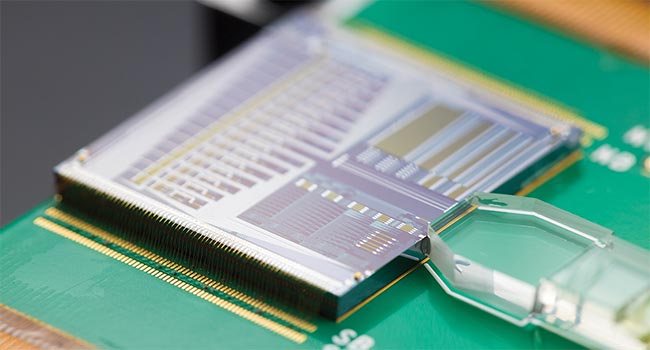
A compact automotive lidar module packaged by PHIX Photonics Assembly. Courtesy of Gijs van Ouwerkerk.
The sensor’s benefits extend beyond tomatoes. It can easily be adapted to other crops. It might even find its way into consumer electronics. For example, smartphones equipped with MantiSpectra’s sensor could be used to check the freshness of milk or other food products.
Research elsewhere is exploring the potential of PICs to make terahertz spectroscopy more portable and cost-effective. Until recently, creating tunable sources and detectors that target this range has been prohibitively expensive. However, integrated photonics allows the mixing
of two laser wavelengths with differential signal outputs in the terahertz region, which opens the door to smaller, more
affordable systems. Prime use cases would be to measure the moisture
levels in leaves (leaf clips) or soil,
and to analyze food for safety and
nutrients.
Integrated photonics is also expanding the possibilities for environmental monitoring. Photoacoustic spectroscopy, for example, is a technique that can be encapsulated in a PIC and used to detect low concentrations of gases, including greenhouse gases such as ammonia, methane, nitrous oxide (N2O), and nitrogen dioxide (NO2). Embedding spectroscopic gas analysis in a chip makes continuous
real-time measurement more viable and can help food producers limit the emission of greenhouse gases in their operations to implement more sustainable agricultural solutions.
Biochip technologies can also play an important role in the safety and quality of food because they allow fast detection of contamination without the need for off-line laboratory tests.
Automotive
Automotive transport is as much of a benefit to individual humans as it is to the world’s growing economies. But as the number of vehicles on our roads continuously rises, so do carbon emissions. This is because 95% of global transport still
relies on fossil fuels3. Using more vehicles also correlates to increased accidents and risk to property and lives.
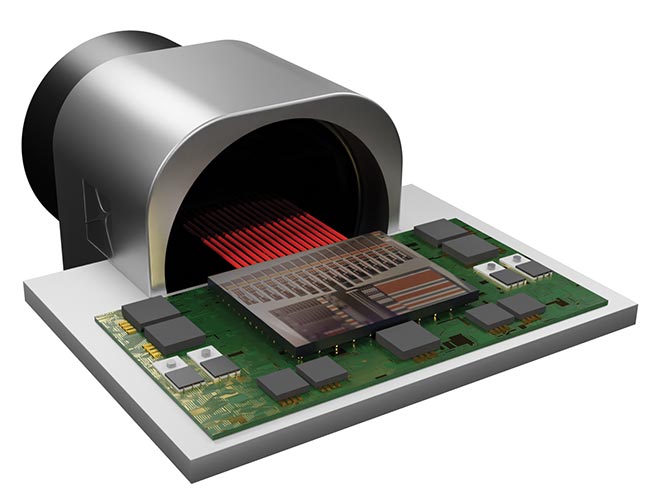
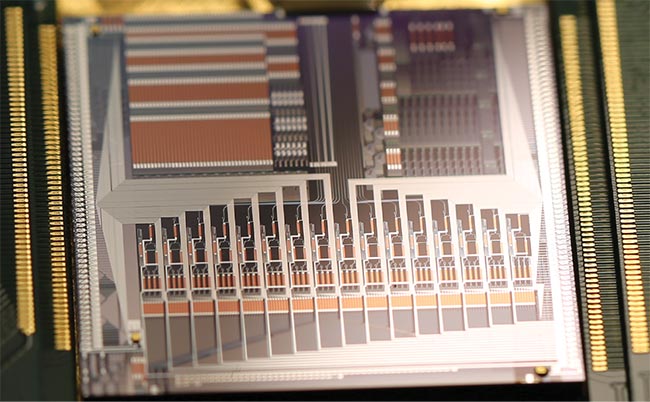
Integrated photonics can make sophisticated frequency-modulated continuous-wave (FMCW) coherent lidar more compact and power-efficient, as illustrated by a lidar engine developed by Scantinel Photonics (top). The engine is driven by a solid-state PIC scanner (bottom). Courtesy of Scantinel Photonics.
One significant challenge for the automotive industry is to break the connection between the benefits and the drawbacks of increased mobility, which explains the growing interest in both autonomous and electric vehicle technologies. For many in the automotive industry, the answer to these challenges lies in advanced driver assistance systems or fully autonomous vehicles.
To make this vision a reality, self-driving vehicles need to both redundantly sense their direct environment and communicate securely with motorists and transport infrastructure. This requires large numbers of sensors and data fusion, which, in turn, demands power-hungry networking and computation systems. As cars become more like a data center on wheels, such communications will also need to be ultrasecure. PIC-enabled quantum key generation and quantum communication devices offer a potential solution. But by integrating multiple optic functionalities into a single chip, integrated photonics can further create accurate, cost-effective, and miniaturized solutions for monitoring systems, fiber optic sensing systems, and lidar platforms. For example, frequency-modulated continuous-wave (FMCW) coherent technology is a more advanced form of lidar that offers higher sensitivity and the ability to measure speed. Until now, the challenge of bringing FMCW solutions to market has been the lack of low-cost, high-volume, high-performance, and lightweight components that manufacturers can easily fit into new vehicles. Encapsulating multiple functions such as these in a compact, power-efficient footprint is where integrated photonics technology excels.
PIC-enhanced FBG sensors also have value in a wide range of automotive applications, ranging from battery power management to load monitoring. Similar to their uses in health care applications, these devices can measure temperature, pressure, strain, and vibration. But in automotive settings, they offer the further advantage of being immune to electromagnetic fields. Combined with integrated photonics, a single FBG can measure several locations within a
vehicle, significantly reducing the weight, wiring, and the number of sensors.
Endless innovation
The ability to shrink large, expensive, and ungainly systems technology down to the scale of a microchip potentially presents many solutions to the world’s biggest problems.
Outside of data and telecom, integrated photonics has huge potential for portable and powerful technologies. The sensing capabilities it offers to health care translate to faster testing, diagnosis, and treatment, toward the goal of better patient outcomes. In agri-food, PIC-based sensors can help food producers ensure optimal conditions for their crops and mitigate disease through earlier detection. In the automotive industry, integrated photonics enables safer self-driving vehicles and safer transport infrastructure and can improve energy efficiency to help reduce carbon footprint.
In recent years, the possibilities that PICs offer to these markets and applications have garnered increasing attention and innovation at research institutes and have accelerated growth in startup companies. They have also fostered broad collaborations, established by such organizations as PhotonDelta, that actively support expansion through a dedicated growth fund and a complete end-to-end supply chain. Community-based approaches such as this can deliver on the true potential of PICs and more quickly usher in new inventions, products, and applications aimed at solving some of the world’s most pressing challenges.
Meet the author
Carol de Vries is CTO at PhotonDelta, where he fosters growth opportunities in integrated photonics. His 40 years of experience in the electronics industry encompasses management and executive roles at several companies —
including Philips, NXP, and Sensata — where he has overseen operations targeting end markets such as automotive, datacom, and health care. De Vries received a master’s degree in physics from Eindhoven University of Technology.
References
1. World Health Organization (Jan. 13, 2020).
Urgent health challenges for the next
decade, www.who.int/news-room/photo-story/photo-story-detail/urgent-health-challenges-for-the-next-decade?utm_source=stat+newsletters&utm_campaign=1931cb646b-mr_copy_02&utm_medium=email&utm_term=0_8cab1d7961-1931cb646b-150708293.
2. FAO, IFAD, UNICEF, WFP, and WHO (2021). The State of Food Security and
Nutrition in the World 2021. Transforming food systems for food security, improved nutrition and affordable healthy diets for all,
www.doi.org/10.4060/cb4474en.
3. U.N. Environment Programme. Why does transport matter?, www.unep.org/explore-topics/transport/why-does-transport-matter.